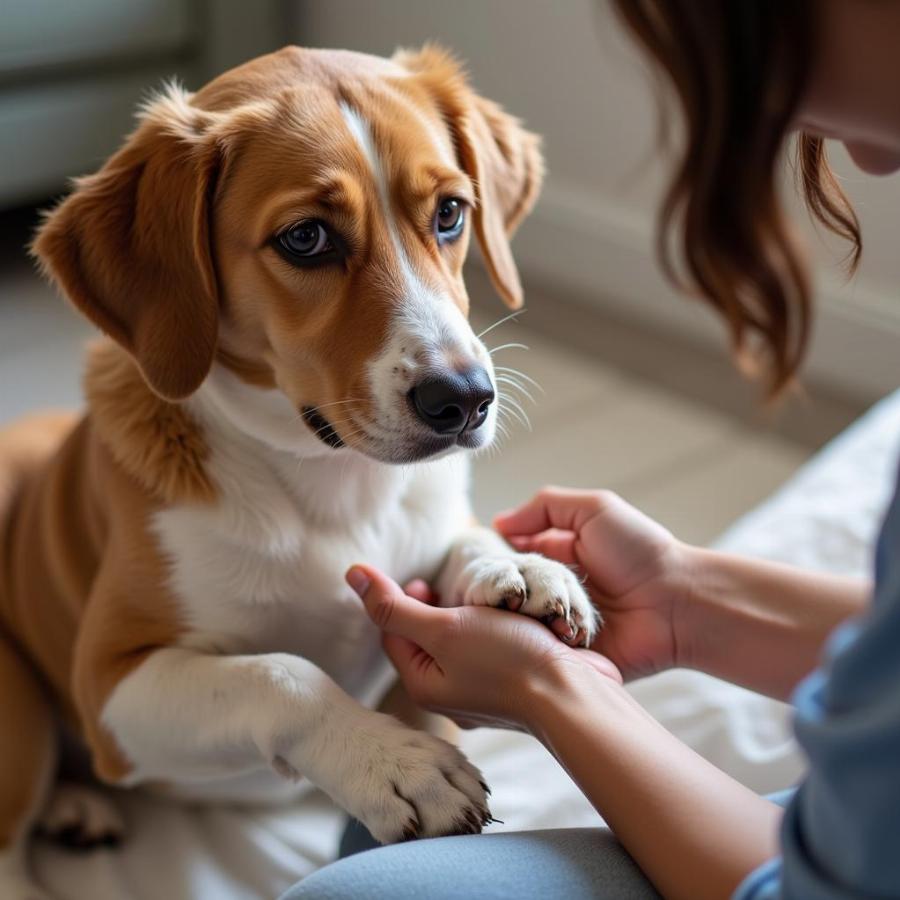Liquid bandage for dogs is a handy tool for pet owners, offering a convenient way to manage minor cuts, scrapes, and wounds. But knowing when and how to use it correctly is essential. This guide will walk you through everything you need to know about liquid bandages for dogs, ensuring you’re equipped to provide the best possible care for your furry friend.
Understanding Liquid Bandage for Dogs
Liquid bandage is a type of topical adhesive that forms a waterproof, protective barrier over minor wounds. It comes in a liquid form that dries quickly to create a seal, promoting healing by keeping the area clean and free from contaminants.
When to Use Liquid Bandage on Your Dog
Liquid bandage can be a valuable tool for various minor injuries on your dog, such as:
- Small cuts and abrasions: It effectively seals cuts and abrasions that are not actively bleeding.
- Hot spots: The waterproof barrier can help protect irritated skin areas, preventing your dog from licking or biting.
- Post-surgery incisions: In some cases, your veterinarian might recommend liquid bandage to help protect small surgical incisions as they heal.
When NOT to Use Liquid Bandage on Dogs
While liquid bandage is useful for superficial wounds, it’s crucial to remember it’s not a substitute for proper veterinary care. Avoid using liquid bandage on:
- Deep wounds: Deep wounds require professional veterinary attention to ensure proper cleaning, potential stitches, and to address the risk of infection.
- Infected wounds: Applying liquid bandage to an infected wound traps bacteria, potentially worsening the condition.
- Wounds near the eyes, nose, or mouth: The chemicals in some liquid bandages can be irritating to these sensitive areas.
- Puncture wounds: These wounds often need to be cleaned and monitored by a veterinarian.
If you’re unsure whether a wound warrants veterinary attention, err on the side of caution and contact your vet.
How to Apply Liquid Bandage to Your Dog
Applying liquid bandage to your dog is straightforward, but it requires a gentle touch and a bit of patience:
- Clean the wound: Gently clean the area around the wound with warm water and a mild antiseptic.
- Dry the area: Pat the area dry with a clean gauze pad.
- Apply the liquid bandage: Holding the applicator close to the wound, apply a thin layer of the liquid bandage, ensuring it covers the entire wound and a small margin of surrounding skin.
- Let it dry: Allow the liquid bandage to dry completely. This usually takes a few minutes.
- Prevent licking: Distract your dog for a few minutes to prevent them from licking or chewing at the bandage while it dries.
 Applying Liquid Bandage to a Dog's Paw
Applying Liquid Bandage to a Dog's Paw
Choosing the Right Liquid Bandage for Your Dog
There are various liquid bandages available, so choosing one specifically designed for pets is important. Look for:
- Non-toxic formula: Ensure the product is safe for use on animals.
- Bitterant-free: Avoid products containing bitterants, which aim to discourage licking but can be harmful if ingested.
- Waterproof and breathable: Choose a bandage that forms a waterproof barrier while still allowing the wound to breathe.
Tips for Effective Use and Aftercare
- Clip the hair: If the wound is in an area with long hair, carefully trim the hair around the wound before applying the bandage.
- Monitor the wound: Check the bandage regularly for signs of infection, such as redness, swelling, discharge, or a foul odor.
- Reapply as needed: Depending on the product and the wound, you may need to reapply the liquid bandage every day or two.
- Contact your vet if: The wound does not show signs of improvement within a few days, or if you notice any signs of infection, contact your veterinarian immediately.
Common Questions About Liquid Bandage for Dogs
Can I use human liquid bandage on my dog?
It’s best to avoid using human liquid bandage on your dog. Some human products contain ingredients that can be toxic to animals.
Is liquid bandage safe if my dog licks it?
While most pet-safe liquid bandages are non-toxic, ingesting large amounts can still cause gastrointestinal upset. It’s best to prevent your dog from licking the bandage.
How long does it take for liquid bandage to come off?
Liquid bandage typically wears off naturally within a few days to a week.
Keep Your Canine Companion Safe
Liquid bandage can be a valuable addition to your pet’s first aid kit. However, responsible pet ownership includes knowing when professional veterinary care is necessary. By understanding when and how to use liquid bandage appropriately and following these guidelines, you can contribute to the well-being of your beloved canine companion.
Still have questions about using liquid bandage on your dog?
Beaut Dogs is your go-to resource for all things dog-related! We are dedicated to providing reliable and insightful information to help you navigate the world of dog ownership with confidence.
For personalized guidance and answers to your specific concerns, don’t hesitate to reach out to our team of experts at [email protected]. Visit Beaut Dogs today and discover a wealth of knowledge to help you become the best pet parent you can be!